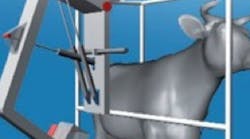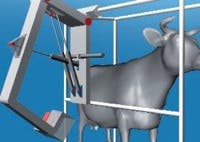With the right sensors and valve technology, engineers at Festo Corp., Hauppauge, N.Y., say servopneumatics can achieve positioning every bit as good as with electric drives. Servopneumatics can serve as an alternative to conventional pneumatic and electric drives and move air cylinders with closed-loop speed and position control.
Festo developed a system consisting of a pneumatic cylinder with an integrated displacement encoder, a proportional valve in place of a simple switching valve, and a position controller, such as Festo's SPC200 axis controller — which is capable of controlling up to four axes simultaneously.
An unusual application of this servopneumatic system is a milking machine built by Lely Industries NV, Netherlands. The machine is essentially a milking robot. The cows themselves decide whether or not to be milked. If they wish to be milked, they enter a stall in which the milking robot is located. A transponder sizes up the cow's vital statistics, such as weight and size. Software can also detect whether the cow had already been milked a short time before.
A robot arm with three axes of servopneumatic motion moves into position to milk the cow. However, because it is pnematic, the robot arm has some "give" to it, so it doesn't injure the cow if it moves. A laser sensor monitors the movement of the cow to make sure that the robot arm can locate the cow's udder.
Festo cites this as an example of a drive of the future — a hybrid drive in which a pneumatic drive and electric drive are integrated into a cylinder and work in parallel on the same handling task. This hybrid drive combines the advantages of pneumatics — durability, low cost, and easy installation and operation — with the accuracy and high dynamics of electric drives. Together, the two technologies create a high-performance drive that can operate quickly and with high precision in confined spaces while transporting large loads.
Click here to see a testimonial from a dairy farmer who uses Lely's system.


